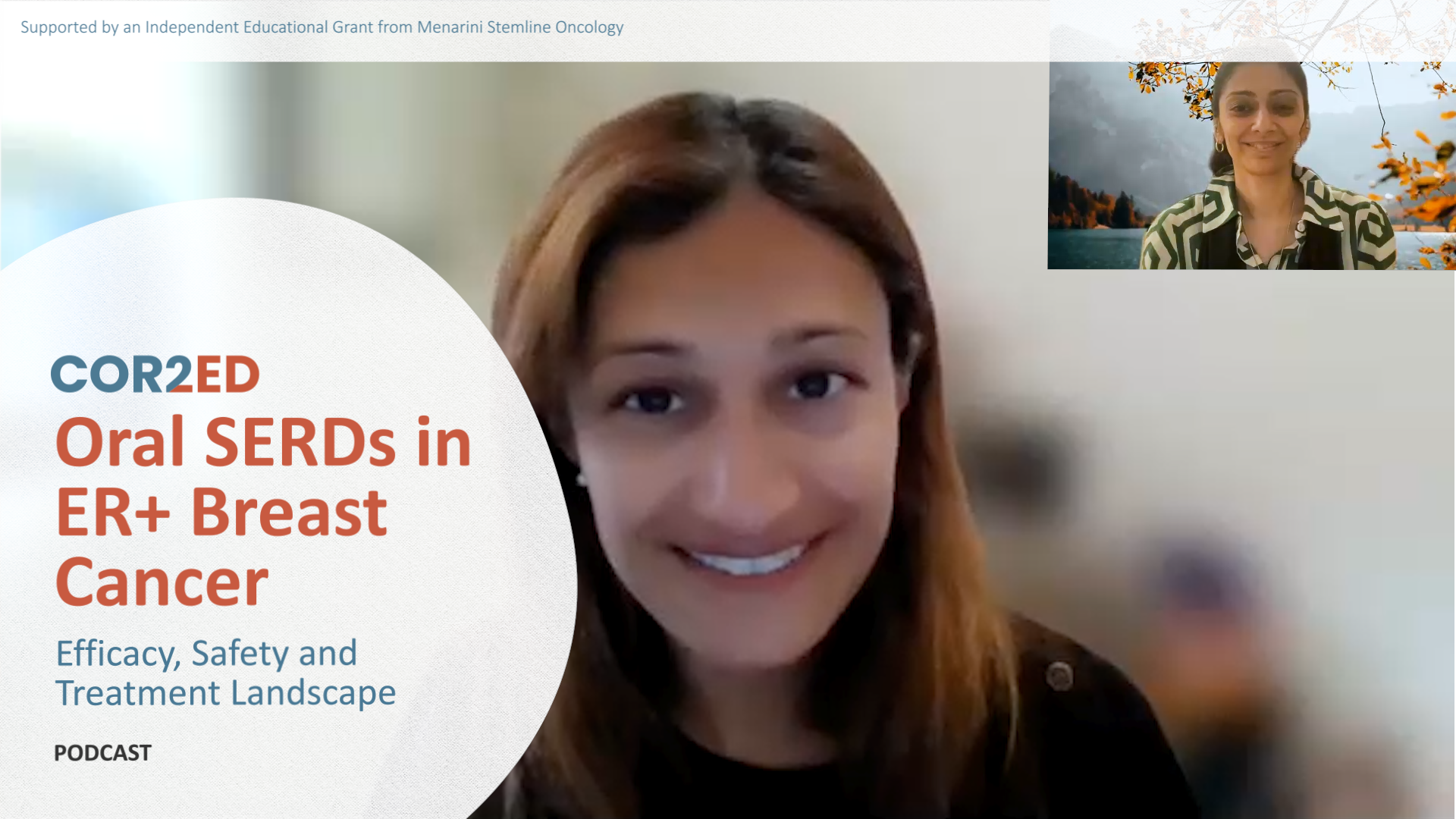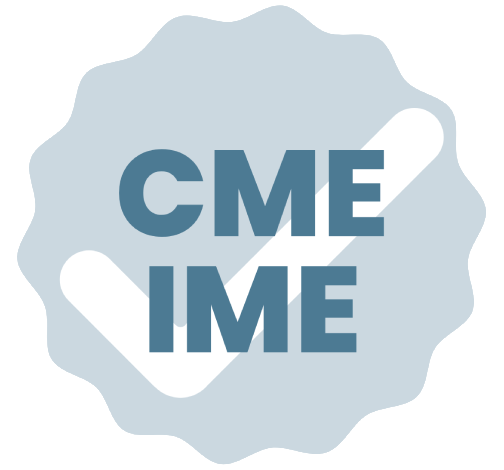BREAST CANCER CONNECT PODCAST 1
Oral SERDs in ER+ Breast Cancer - Efficacy, Safety and Treatment Landscape
Tonke de Jong
Welcome, and thank you for listening to this podcast from COR2ED Independent Medical Education. In this episode, you will hear from our experts, Dr Rena Callahan and Dr Shaheenah Dawood, as they will discuss oral SERDs, a novel therapy for ER+/HER2- advanced or metastatic breast cancer. The experts take a close look at the EMERALD trial, and discuss the treatment landscape and future prospects for oral SERDs.
This podcast is an initiative of COR2ED and developed by BREAST CANCER CONNECT, which is a group of international experts working in the field of breast cancer. The podcast is supported by an independent educational grant from Menarini Stemline Oncology. The views expressed are the personal opinions of the experts, and they do not necessarily represent the views of the experts' organisations or the rest of the Breast Cancer CONNECT Group. For expert disclosures on any conflict of interest, please visit the COR2ED website. Now, with that being said, let's get started.
Dr Rena Callahan
Hello, all. I am Dr Rena Callahan, an Associate Clinical Professor of Haematology Oncology at the University of California, Los Angeles, David Geffen School of Medicine. I'm delighted to be joined today by Dr Shaheenah Dawood, a Consultant Medical Oncologist and Professor of Oncology at Mediclinic City Hospital, United Arab Emirates, Dubai.
Dr Shaheenah Dawood
Thank you, Dr. Callahan. It's truly a pleasure to be here today. First of all, I'd like to invite the audience to follow us in this exciting new series made up of at least three episodes discussing a new topic on new oral endocrine therapy options for patients with ER+/HER2- advanced or metastatic breast cancer. Now with the first podcast that we're going to be doing today, we will be discussing the efficacy and safety profiles of oral SERDs and truly understanding their place in the evolving treatment landscape.
Dr Rena Callahan
I really look forward to this discussion with you, Dr Dawood, because we're going to talk about a very exciting new therapy. We've known for years that endocrine therapy represents the backbone of treatment for oestrogen receptor positive breast cancers. However, there hasn't been a new endocrine agent for 20 years, so SERDs have been instrumental in managing breast cancer that has progressed on an aromatase inhibitor, however, so far, had only been available as an intramuscular injection with limited bioavailability.
Oral SERDs now have improved upon both efficacy and delivery and are ready to be integrated into our clinical practices. Therefore, we need to review the data on approved and potentially soon-to-be-approved oral SERDs so our patients can immediately start benefiting from this important advance in therapy. What are your thoughts, Dr Dawood?
Dr Shaheenah Dawood
I absolutely agree, and if I may add, it is also true that over the last few decades, we have learned several important lessons in the management of patients with ER+/HER2- metastatic breast cancer, including the fact that first line endocrine therapy is equivalent to chemotherapy in the absence of visceral crisis. Second, we know that sequential endocrine therapy is now the standard of care for these patients. And third, we know that combination endocrine therapy with a CDK4/6 inhibitors in that first line setting improves both progression free survival as well as overall survival, beyond using endocrine as a mono-therapeutic agent. Now what we do beyond progression in an endocrine resistant cohort has been the focus of recent research with oral SERDs representing a new class of drugs that could potentially be used in the subgroup of patients with endocrine resistant disease who have an ESR1 mutation.
Dr Rena Callahan
Absolutely Dr Dawood. This is a very exciting time. In fact, January 2023 marked the beginning of the oral SERDs era with elacestrant being the first to be FDA approved and expected to be EMA approved later this year. This approval was based on pivotal data from the EMERALD Phase three trial, which enrolled men and postmenopausal women with ER+/HER2- metastatic breast cancer, who had previously received endocrine therapy, including fulvestrant.
Results from this trial demonstrated significant improvements of progression free survival in patients with ER+/HER2- metastatic breast cancer who were treated with elacestrant versus standard of care endocrine therapy in the second and third line settings, especially in patients with ESR1 mutations.
One key feature of the EMERALD trial is that all patients had to be pretreated with CDK4/6 inhibitor. What do you think is the clinical consequence of having this requirement for a CDK4/6 inhibitor pretreatment as an inclusion criteria?
Dr Shaheenah Dawood
Great question, Dr Callahan. I think, as I've previously mentioned, endocrine therapy in combination with CDK4/6 inhibitor has completely revolutionised the current treatment landscapes of these patients with ER+/HER2- advanced or metastatic breast cancer, so much so that it's now become the standard of care to give combination endocrine therapy with a CDK4/6 inhibitor in that first line setting or even in subsequent settings. So, I think having it as an inclusion criteria was paramount to making it applicable in our clinical setting in terms of using that oral SERD. As the EMERALD trial included a real-world experience, it makes sense to require CDK4/6 inhibitor use as an eligibility for a study that is, in fact, trying to address how a second line therapy performs, and that's exactly what it did, especially because we now know that most tumours eventually will become resistant to endocrine therapy, often due to the development of an ESR1 mutation.
Dr Rena Callahan
So, do you think that subgroup analysis on CDK4/6 inhibitor pre-treated patients can elucidate not only how CDK inhibitor exposure impacts treatment sequencing decision, but more specifically, if the duration of exposure affects sequential treatment efficacy?
Dr Shaheenah Dawood
So, I certainly think that CDK4/6 inhibitor duration of therapy and exposure will influence to a certain extent. I'm not sure if the duration in isolation impacts sequencing decisions. I think sequencing decisions are dependent on multiple factors, including duration of prior exposure of CDK4/6 inhibitors, including factors such as tumour burden, performance status and other targets that can help guide that therapeutic management of those patients with ER+/HER2- metastatic breast cancer.
It's truly a complex interplay of multiple factors. It is the art of individualising therapy, which is what we want to do for our patients at the end of the day. But that being said, I do think that CDK4/6 inhibitor duration of exposure impacts the efficacy of oral SERDs. And we've certainly seen that in the subgroup analysis of the phase 3 EMERALD trial data. A landmark analysis compared progression free survival results in the group of patients who were taking elacestrant, versus the group of patients who were taking standard of care therapy, based on the duration of prior exposure to CDK4/6 inhibitor, and essentially what the authors showed was that a longer prior duration of CDK4/6 inhibitor was positively associated with a longer progression free survival in patients who were treated with elacestrant but not with standard of care.
And a question that I would now like to pose to you, Dr Callahan, is how early or late should we be using elacestrant post CDK4/6 inhibitor? Which is currently the multimillion-dollar question that we're all asking as community oncologists.
Dr Rena Callahan
Right, I mean, that's a great question because we know exactly what to do in first line treatment - we all use endocrine therapy and CDK inhibitor. Where it gets a little murky is what to do in second line. A lot of these patients have had a significant period of time where they've had an excellent quality of life with a tolerable therapy, and we want to keep that going as long as possible. So, I think it makes the most sense to use it as soon as possible after a CDK inhibitor therapy. So, we're talking second line. So, if a patient had CDK inhibitor and aromatase inhibitor first line, I'd feel more than comfortable using elacestrant in the second line, of course, taking into consideration patient and tumour specific features.
Dr Shaheenah Dawood
So let me pose another question to you Dr. Callahan. What about the ESR1 mutation cohort that was included in the study? As you know, about 40% of these patients did have an ESR1 mutation in that phase 3 EMERALD study. How does it affect elacestrant efficacy in this particular patient cohort?
Dr Rena Callahan
The EMERALD trial included patients with and without an ESR1 mutation. But if we look at the same data in patients who harbour an ESR1 mutation, we see even more marked improvements in progression free survival. Patients with an ESR1 mutation had a median progression free survival around 3.8 months, whereas patients on standard of care endocrine therapy closer to two months. And then looking at landmark analysis by duration of CDK inhibitor therapy, we see that patients who were on CDK inhibitors for longer periods of time had greater improvements in landmark progression free survival. So, for example, patients who had previously been on at least 12 months of a CDK inhibitor had a tripling of progression free survival with the use of elacestrant versus standard of care endocrine therapy, a marked improvement. So, I think that that is one of the reasons why the FDA approval was at this time restricted to patients who have an ESR1 mutation.
So, when do you think is the best time to test for an ESR1 mutation in the advanced and metastatic settings, and how should we go about doing this?
Dr Shaheenah Dawood
Excellent question, Dr Callahan. I think another question that we've all been asking ourselves since the data for the EMERALD trial came out and the approval by the FDA in January, restricting it to use only in patients with an ESR1 mutation. It is clear that ESR1 mutation is now an established biomarker for the treatment of patients with an ER+/HER2- advanced or metastatic breast cancer.
But I think it's important to remind ourselves and the audience out there that upfront testing prior to therapy with an aromatase inhibitor in that metastatic setting is unlikely to pick up an ESR1 mutation. In fact, only approximately 1% of patients who are endocrine therapy naive, such as those stage four de novo patients with metastatic breast cancer, actually have a detectable ESR1 mutation. On the other hand, almost 40% of patients following prior exposure to an aromatase inhibitor in that metastatic setting will develop an ESR1 mutation. So, it becomes important to at least test again after first line therapy or even at other time points when you feel that the patient may have acquired an ESR1 mutation post progression on an aromatase inhibitor.
In regards to how we test, generally we use a liquid biopsy platform that is recommended for the detection of an ESR1 mutation. More specifically, the NCCN guidelines recommend an NGS or a droplet PCR platform. However, in the US, the FDA has specifically approved the Guardant360 companion diagnostic assay to identify patients eligible for elacestrant treatment.
Now we've discussed elacestrant efficacy. We've analysed subgroup data for both the CDK4/6 pretreated patients and the ones that have been harbouring an ESR1 mutation. My question to you, Dr Callahan, is, do you think that the safety of elacestrant is as optimal as its efficacy because that will be important for patient quality of life at the end of the day?
Dr Rena Callahan
Thanks so much for that question Shaheenah, I completely agree with you that safety is very, very important, especially when we're talking about second line. As I mentioned earlier, we want to keep that quality of life going as long as possible so patients can live very full lives - jobs, family, doing what they want to do. And I found, so there's the data that we'll review from EMERALD as well as my personal experience, that it is very, very tolerable and safe.
So, if we look at the data from EMERALD, 27% of patients receiving elacestrant experienced grade three or four adverse events, compared with about 21% receiving standard of care therapy. Most common high-grade AEs included nausea, back pain, increased ALT but this was only in about 2% of patients. And we compare this to nausea, fatigue, diarrhoea, increased AST in the standard of care arm occurring in about 1% of patients. So very comparable.
Additionally, I think it's important to look at, do patients discontinue treatment due to adverse events, and this was pretty uncommon. In the elacestrant arm only 6% of patients discontinued therapy due to AEs, compared with 4.4% in the standard of care arm. So very tolerable.
So based on this data, where do you think, Dr Dawood, elacestrant fits into the current treatment landscape for oestrogen receptor positive HER2- advanced or metastatic breast cancer?
Dr Shaheenah Dawood
I think, you know, again, a multimillion-dollar question where we're trying to individualise those sequencing strategies because there's been such an explosion of data and biomarkers that are helping us guide therapeutic management in this specific cohort of patients. But to specifically try and answer the question you were asking, I think it would be a cohort of patients with an ESR1 mutation positive disease, which occurs in about 40%, like I mentioned previously. How soon or late this develops will obviously impact how early or late I will use elacestrant.
Sequencing strategies in the ESR1 mutation cohort where there are no other biomarkers present will make me want to use elacestrant as early as possible, probably straight after a CDK4/6 inhibitor plus that aromatase inhibitor. And if there's an ESR1 mutation cohort of patients where I'm trying to sequence, but there are other biomarkers that are present like a PIK3CA mutation or a HER2 pathogenic mutation, or even some of those agnostic markers like NTRK fusions that will be a little bit more complex. But the earlier you use the elacestrant, I think the more efficacy you're going to be able to gain from using that drug.
Now, a question that I know no one has addressed and something that stares at us in the face daily would we're looking at that data from the EMERALD study. Is it although elacestrant has been approved in the ESR1 mutation cohort, when we look at EMERALD data, it looks to be equivalent to fulvestrant in the ESR1 wildtype cohort. And it's also more easy to use because it's an oral tablet compared to an intramuscular injection that we need to use with fulvestrant. So, would you consider using elacestrant in that ESR1 wildtype patient? Administration is certainly going to be easier.
Dr Rena Callahan
Yes, absolutely, you know, and I wish that the FDA approval were more broad because, you know, elacestrant, while the efficacy is most pronounced in the ESR1 mutated population, it doesn't perform less well in patients without ESR1 mutations and it offers some advantages. Most patients don't want two intramuscular injections once a month. Some live very far from the clinic and prefer an oral therapy.
So, I would use it if available and also exciting are upcoming combination data. There are ongoing studies looking at combinations of oral SERDs. So, with elacestrant, we have the ELEVATE Trials which have combinations of elacestrant with different CDK inhibitors, everolimus, alpelisib. So, we'll know if they can be safely combined and if this improves efficacy to give us some more second or third line options.
There are other oral SERDs in development, camizestrant, imlunestrant. However, right now we don't have any phase 3 data and right now we cannot compare different oral SERDs because they have different patient populations. But in general, my feeling is that it's always good to have multiple options.
Dr Shaheenah Dawood
So let me make the question more difficult for you, Dr Callahan, because sequencing I've just. I've just touched on that topic about sequencing, but sequencing is going to be all the more difficult now with the introduction of the first oral SERD in the form of elacestrant, in those patients with an ESR1 mutation. So how would you optimally sequence your patient if there are other biomarkers available for that patient? For example, the presence of a PIK3CA mutation or a BRCA mutation or HER2 pathogenic mutation, how would you optimally sequence if that patient has an ESR1 mutation, where would you place elacestrant in that sequencing pathway?
Dr Rena Callahan
That's a great question, and we don't have a whole lot of information yet on the impact of those mutations on patients who are given single agent elacestrant. We do have FDA approved therapies for patients who have PIK3CA mutations or germline BRCA mutations, not yet with HER2 mutations, and so we do have options to use those therapies, but we need more data to help us sequence these agents, and especially the combination data that I referred to previously.
Dr Shaheenah Dawood
Absolutely. Thank you so much, Dr. Callahan. We're now at the end of the podcast, and I think I've had a lot of fun discussing the new oral SERD elacestrant. We've discussed efficacy, we've discussed safety profile of this new oral SERD, and we've tried, we really have tried, to see where we can place it in that sequencing strategy amongst patients with an ESR1 mutation ER+/HER2- advanced or metastatic breast cancer with or without other biomarkers being present. But you've heard that it's not as simple, and I think the art of oncology now is personalised therapy, and that's where you discuss your cases in the MDT.
But just to give you some clinical takeaways, and I think these are very important messages that I think I've taken back from this podcast, the first episode, is number one - in January 2023, elacestrant was the first and currently the only oral SERD to be FDA approved with optimal efficacy and manageable safety for patients with an ESR1 mutated ER+/HER2- advanced or metastatic breast cancer. We know that elacestrant has a longer progression free survival result and are positively associated with a longer duration of prior CDK4/6 therapy and are even more pronounced in patients with an ESR1 mutation. We have heard that data.
ESR1 mutation testing should be done with a liquid biopsy platform at the time of progression on aromatase inhibitor as well as after subsequent lines of progression if you have not detected an ESR1 mutation earlier on. Oral SERDs are being studied in combination with targeted therapies like CDK4/6 inhibitors, PIK3CA inhibitors as well as AKT inhibitors, and I personally am looking forward to seeing a number of different oral SERDs making its way into the clinic, which is just going to open up doors and opportunities for our patients to be able to treat them more optimally in the future.
Dr Rena Callahan
Dr Dawood, I've had a lot of fun today discussing elacestrant and oral SERDs and participating in this podcast and can't wait to do it again. And, of course, a big thank you to everyone in our audience. We are all in this together, right? I invite you to listen to our next podcast where we'll have an exciting opportunity to apply what we've discussed today on two different patient case studies, so follow along to learn more about that.
Dr Shaheenah Dawood
Yes, definitely. Thank you all for joining us today. It's been a huge pleasure discussing with you, Dr Callahan, and see you next time.
Tonke de Jong
We hope you found this podcast informative and enjoyable. If you like this episode, you should look on the COR2ED channel for more. In particular, look out for the next two podcasts with Dr Callahan and Dr Dawood, where they will present patient case studies with ER+/HER2- advanced or metastatic breast cancer, and discuss treatment options, including oral SERDs, sequencing decisions and adverse event management. Make sure to listen to those episodes too. Also, don't forget to rate this episode on the COR2ED website and share our podcast on social media or maybe with your colleagues. Thanks for listening, and see you next time.
This podcast was brought to you by COR2ED Independent Medical Education. Please visit cor2ed.com for more information.














 Downloadable
Downloadable  5 MIN
5 MIN
 Jun 2025
Jun 2025 






